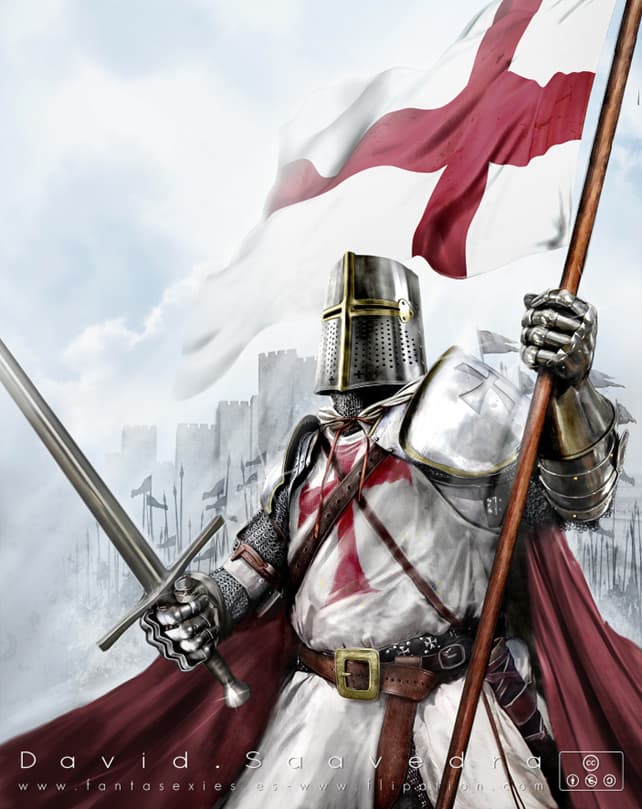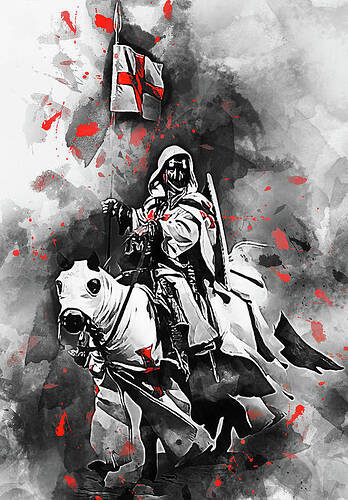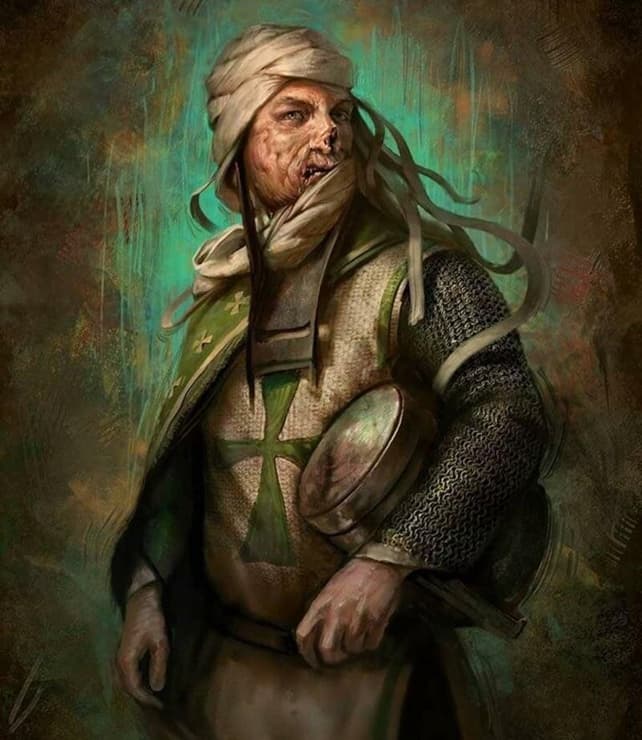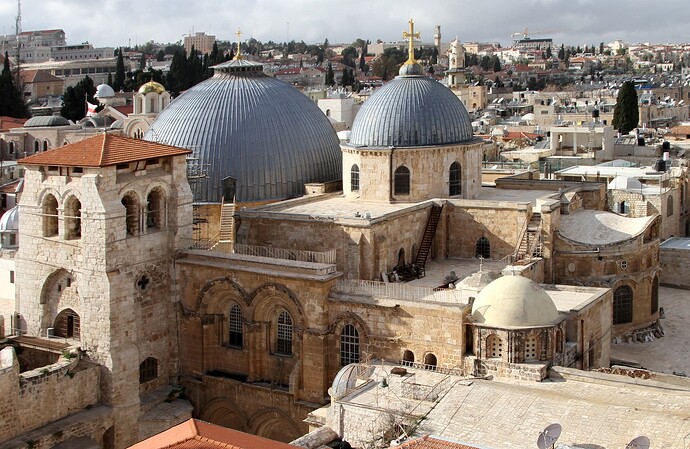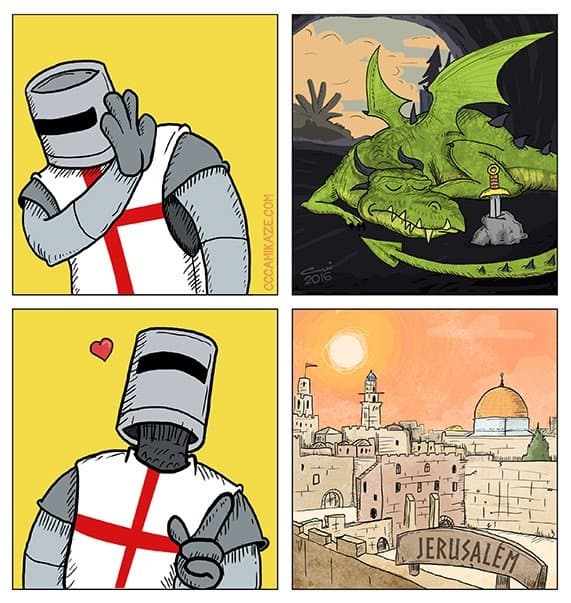Crusader States – Order of Many Things
1090-1273
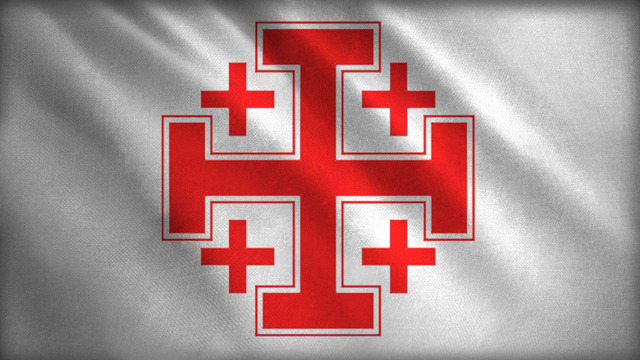
Religion, Sacred Sites, Defensive
Difficulty: 3/3
Bonuses
• Unique crusader unit can capture Sacred Sites
• Relics decrease production of Military Units (10% per relic)
• Reduced cost of Keeps and Walls.
• Sacred Sites increase villager gathering rates (5% per site)
• Transport ships can carry 5 additional units
• Monks cost and production time reduced by 30%.
• Military ships cost reduced by 15%
Deus Vult! – The number of relics held increases the effectiveness of Holy Fervor by 2% for each relic
Military barracks and stables built within the Monastery / Hospital influence area can produce Crusaders and Templar Knights.
Call of the Crusade – Can call upon the Crusade, an Army of Crusaders will show up at Landmark TC. Holding a Sacred Site will increase the level of this ability, increasing the size of the army called upon.
Level 1: call forth an army of 3 Crusaders and 1 Templar knight
Level 2: call forth an army of 6 Crusaders and 3 Templar knights
Level 3: call forth an army of 10 Crusaders and 5 Templar knights
Level 4: call forth an army of 13 Crusaders and 7 Templar knights
The more Sacred Sites held, the faster it levels, can be used every 8 minutes.
Unique Landmarks
Feudal Age:
• St.John Hospital of Jerusalem - Functions as a hospital with a wider influence area, and can store relics, each relic stored increases the healing effect of all hospitals. Adds an additional 2 crusaders per level for the Call of the Crusades.
• Church of Saint Peter - Functions as a Monastery. Relics stored in this structure cause traders to drop off 4% additional resource per relic stored in this landmark (up to 3 relics)
Castle Age:
• Temple Domini (Dome of the Rock) - Grants Templar knight aura to give 10% movement speed to nearby units. The production speed of knights produced in this building decreased by 50%. Has the ability “Devine Visions” that reveals the current location of all relics for 10 seconds.
• Domus Leprosorum - Military Units with below 40% health can be exchanged into additional Lazarists Crusaders when garrisoned into the landmark.
Is also able to call forth a band of Lazarist Crusaders. Function similar to the rus Kreml levy militia.
Imperial Age:
• Fortress of Acre - can produce a band of Landsknecht, Arbaletiers, or Longbowmen. When using Call of the Crusade, it adds 1 additional Templar knight per level. Produces 1 gold per active trader.
• Krak des Chevaliers - Keep with all upgrades, Units produced in Military production buildings built within its influence are 20% cheaper. Call upon the Crusade can be called from any keep, rather than Town Center only.
Wonder:
• Church of the Holy Sepulchre
Unique Buildings:
• Hospital (150W):
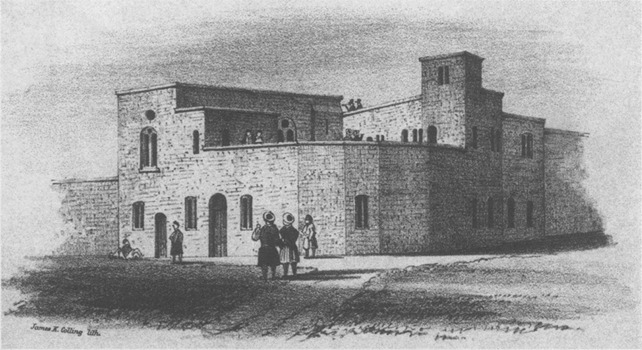
Heals nearby units within a large radius. Can be upgraded to produce passive gold income.
Unique Units:
• Crusader (120F 35G):
Heavily armored, slow-moving, hard-hitting unit. Counts as a Religious unit and can not be converted. Has a passive ability: Holy Fervor; when the unit is below 15% health, gains an increased 2% attack speed.
• Templar Knight (110F 140G):
Replaces the Knight, Armored Cavalry unit with an Aura that grants Holy Fervor to nearby units. (and 10% movement speed via Landmark)
• Lazarist Knight (Landmark unit only)
Similar to the Kreml Militia, these units are as strong as a Man at Arms. And can be called upon if you have the Domus Leprosorum landmark, by using the Levy Order of St. Lazarus.
They have Leper Unease which reduces unit damage by 20%, they also possess Will of St. Lazarus which has them immune to damage for 0.3 seconds when they hit 1% health. (Causes them to ignore overkill)
Unique Technologies:
• Crusader’s Resolve (Age II 75F 125G): Crusader charge speed is doubled when below 15% health.
• Papal Bull (Age II 150G): Crusader Unit can now Capture Sacred Sites before Age III
• Reclaim the Holy Land (Age III 500G): Each relic site not controlled decreases the cooldown duration of the next Call of the Crusade by 1 minute
• Planned settlements (Age III, 75W 200G): Villagers produce 10% faster
• Islamic Medical Practices (Age III 100F 250G): Increases Hospital healing effect.
• Water Management (Age III): Gather rate from farms is increased by 5%
• Flail (Age IV 150F 350G): Grants Templar Knights +4 Bonus to Heavy Units
• Letters of Credit (Age IV 200F 350G): Hospitals produce 5 gold every 5 seconds.
Additional Notes:
Architecture: Crusader States architecture became something of its own, starting based on Byzantine structures that dominated the area after having been under Byzantine control, over time they added the northern French, Aquitanian, and Provencal styles into their grand buildings. One thing that got heavily incorporated later on in the Crusader States was Wall Mosaics, which was practically unknown in the West at its time, but commonplace among the Byzantine and Muslims who inhabited the area.
Naval units: Uses European-style naval ships, as most of their naval power stemmed from the crusading nations such as the Franks, and over time primarily relied on the maritime republics of Italy such as Venice, Genoa, and Pisa.
Later on there were adaptations on the European style ships, where Triangle lateen sails were incorporated into their vessels.
Language progression: The language of the Outremer as the settlers and crusaders were often called was mainly old French, as most of the first Crusaders were Franks. However, the Levant region was filled with various people groups, both from the Muslims surrounding them but also from the old Byzantine empire that had dominated the region for a long time.
Latin was often spoken among some Orders, but French was often the common denominative.
As the Kingdom of Jerusalem and its fellow crusader states started to form and settle, the generation after the first crusaders, the ones that started seeing themselves as native to the land started exchanging a lot of knowledge between them, along with it, absorption of language.
So the French spoken here over time wouldn’t be your classical French that we know it, but it wouldn’t be far-fetched to see that “Outremer French” developed similar to the French you see in Quebec and many of the other French colonies around the world. In this case, a lot of Greek, Aramaic, and Arabic loan words would be incorporated.
Landmark references:
St.John Hospital of Jerusalem:
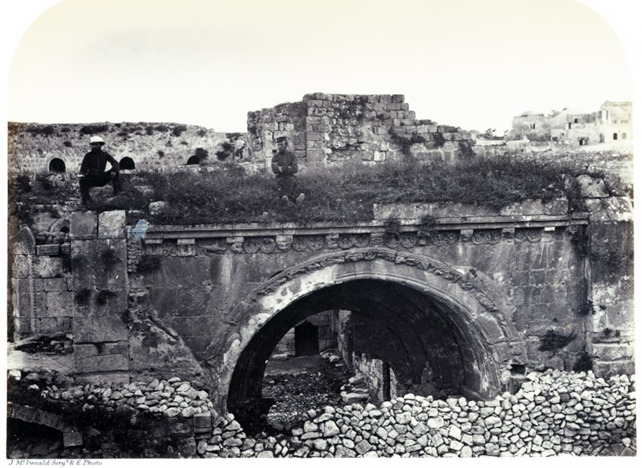

Entrance of the St.John Hospital of Jerusalem.
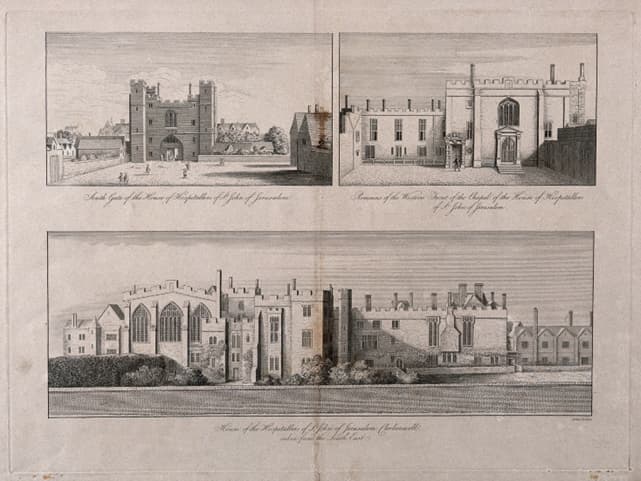
Image Draft of what they assumed St.John Hospital of Jerusalem might have looked like.
St.John Hospital is where the Meme first started. I mean the Crusaders that we know of today and so famously used in so many memes.
St.John Hospital was the first place where they used an ambulatory service to bring in sick and wounded people to the hospital, they also had riders on camels and horses functioning similarly as ambulance vehicles do today. (i.e. look at newly announced Ayyubid camel riding Dervishes).
The building was situated in the heart of the old Christian Quarter in the Old City of Jerusalem.
Contemporary historical documents, mention a sophisticated hospital that was as large and as organized as a modern hospital today, well without the fancy electronics and equipment of course.
This is also where the Order of Knights of the Hospital of Saint John of Jerusalem, aka The Knights Hospitaller started by a man with almost mythical Origins known as Pierre Gerard or Gerard Tenque, neither his homeland, family, or education was known, yet all indication leads to him being the one who Founded the famous Order that still lives on to this very day. I mean, you can just book some tickets to Malta and see for yourself. It’s a nice place. Highly recommend. Never been there myself. Maybe I should listen to my advice…
• Church of Saint Peter:

One of Christianity’s oldest Churches, the oldest surviving parts dating back to the 4th or 5th century. Crusaders of the First Crusade who captured today’s Antakya, formerly known as the ancient city of Antiochia, became the Principality of Antioch under the Outremer (Crusader States) reign. Lengthened the church by a few meters and connected it with two archers to the façade which they constructed.
The gardens of the Church were also used as a cemetery for centuries and graves and burials have been located inside the Church, especially around the altar. The Church is the final resting place of Tancred, Prince of Galilee, and the Holy Roman Emperor, Frederick Barbarossa who died in the Third Crusade. From drowning. (Which caused many of the HRE Crusaders to abandon the crusade)
Antioch itself was a renowned city, the cradle of Christianity, as the terminology of Christians was first recorded here, and as the Jewish population here was not as bound to the temple Judaism and thus the first Christian missionaries after the death of Christ started to convert the city Jewish population into Christianity. Antioch was said to rival Rome in its size and splendor and has been subjected to constant destruction and reconstruction, either from natural disasters (being built on a fault line doesn’t help) or by the ravages of countless wars.
It was called the Rome of the East due to its influence, culture, and military might.
The Principality of Antioch prospered economically despite its domestic unrest and Muslim onslaughts. Because trade was vital to Christians and Muslims alike, agreements were reached to enable trade to continue despite the difference in religion.
Trade goods from the Persian Silk Road, such as spices, silk, dyes, and porcelain were shipped to the European markets. Orchards and olive groves supplied lemons and olive oil for export, and wood from the forests of Lebanon was traded to the Egyptians in exchange for fine cloth.
• Temple Domini:
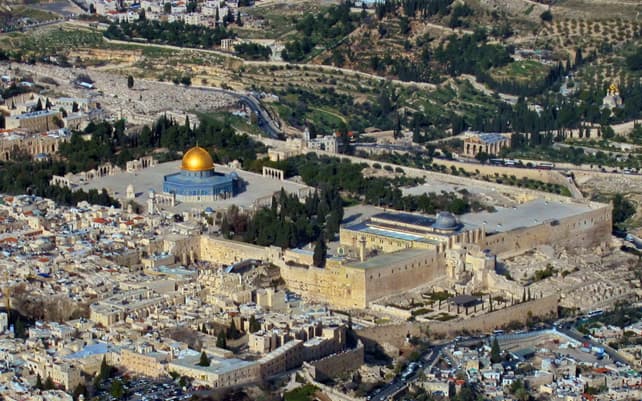
Templum Domini also known as the Dome of the Rock in Jerusalem became an important symbol, depicted on coins that circulated inside the Christian Kingdom of Jerusalem.
Dome of the Rock was originally erected in the late 7th Century under the Umayyad Caliph Abd al-Malik ibn Marwan at the site of a former Jewish Second Temple. After its capture by the First Crusade, it was given to the Augustinian Canon Regular who renovated and turned it into a Catholic Church. The Adjacent Al-Aqsa Mosque was called Templum Solomonis (Temple of Solomon) by the Crusaders and it was from this they derived their name; The Poor Follow-Soldiers of Christ and the Temple of Solomon, more commonly known as Knights Templar.
The King of Jerusalem gave the building to the Knights Templars after his palace near the Jaffa gate was completed.
• Domus Leprosorum:
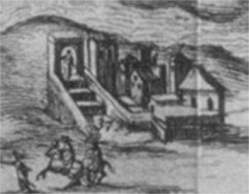
The origins of the Military and Hospitaller Order of Saint Lazarus are shrouded in a haze of myth and legend, and through the passage of time and chaos of war, essential documents about them have been lost.
The Order’s presence was however still a reality after the conquest of Jerusalem by the Crusaders. The re-organization initiated in the hospitaller services available in the Holy City resulted in the setting up of two Hospitaller Orders, both abiding by the Rule of Saint Augustine.
The First order became known as the Knights Hospitallers under the patronship of St. John, who were within the City Walls, and the second order, under the patronship of St. Lazarus Became known as the Order of Saint Lazarus of Jerusalem, also known as the Leper Brothers of Jerusalem, often referred to as Lazarist. Who had the responsibility to take care of the sufferers of Leprosy?
Any knight in the catholic army who was diagnosed with leprosy was taken to the hospital and cared for. The services of the hospital were so profound that the Kings and rich merchants used to donate hefty amounts in the name of charities and welfare.
Many who were Crusaders themselves from various Orders would often find themselves joining the Order of St. Lazarus once they had contracted the horrible disease.
King Baldwin IV was famously known as the Leper King of Jerusalem, a highly competent king despite his young age, was admired by his contemporaries and historians for his willpower and dedication to the Kingdom of Jerusalem. Despite the disabilities he gained from Leprosy that eventually left him blind and unable to use his hands and feet. He managed to protect the kingdom from the Muslim ruler, Saladin throughout his reign.
• Citadel of Acre:
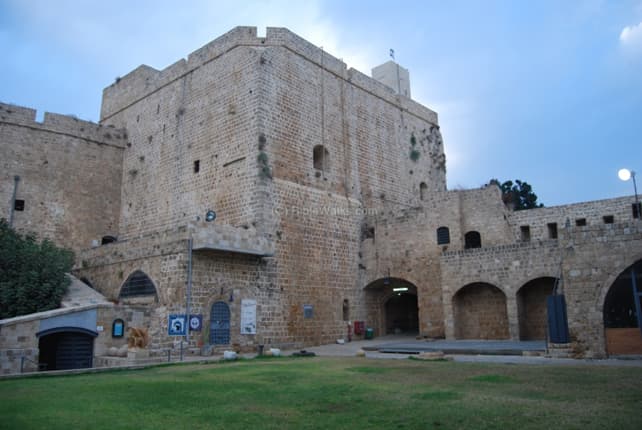
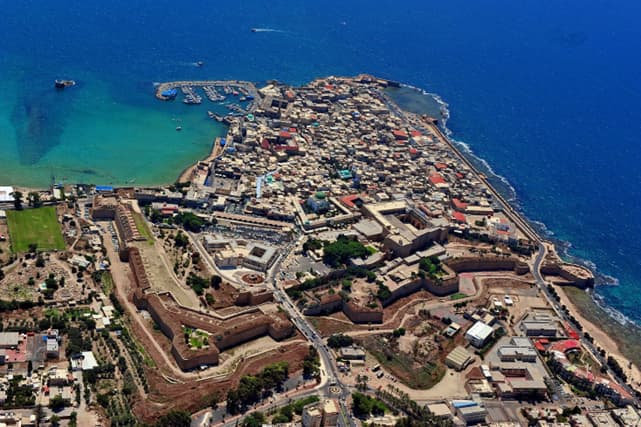
Built by the Knights Hospitallers in the 12th century, Acre served as a maritime foothold on the Mediterranean coast of the southern Levant. The Fortress was built directly in the center to ensure the vital supplies coming to and from Europe. In the fortress, there were rooms for all different uses, from hospitals, dining rooms, public baths, and massive halls used for varying purposes. The Kingdom of Jerusalem was regarded in the West as enormously wealthy above all because of Acre, as its access to the Asiatic spice trade made trade flourish.
• Krak des Chevaliers:
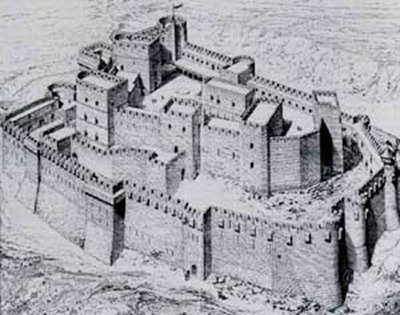
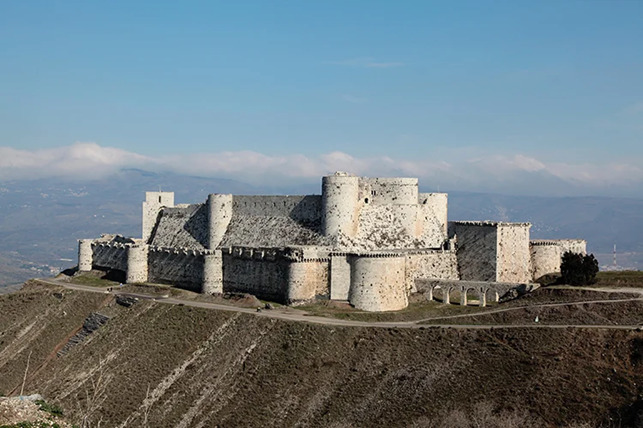
Krak des Chevaliers was among the most important castles among the many castles and strongholds held by the Crusaders. Located at the border of the County of Tripoli, it acted as the Administrative center and a military base. It housed a garrison of around 2000, which allowed it to exact tribute from a wide area.
This lasted as long as Saladin’s successors warred between themselves, until Baibar became the new Sultan of Egypt, and started to unite the warring Muslim States. Which in return led the nearby towns to stop paying tribute to the Hospitallers. Baibars laid siege to the castle, he used Mangonels against the castle hence the Ayyubid unique Mango. They managed to breach of the tower in the southwest corner forcing the Crusaders to pull back to the more formidable inner ward. After a lull of ten days, besiegers conveyed a letter to the garrison, supposedly from the Grand Master of the Knights Hospitaller in Tripoli, which granted permission for them to surrender.
The Letter was however a Forgery, but the Sultan spared their lives. The new owner began immediate repairs and turned the Hospitaller chapel into a mosque.
Wonder:
• Church of the Holy Sepulchre:
This place used to be the site where some guy called Jesus was Crucified. And his empty tomb where he was buried and resurrected.
Due to this, it is considered the holiest site in Christianity.
The Church was rebuilt multiple times, and each time some of the antiquities from the preceding structure were used in the newer renovation. The tomb itself is enclosed by a 19th-century shrine called Aedicule. A Status Quo, understanding between religious communities applies to the site.
The Church is also known as the Church of the Resurrection, or Church of the Anastasis by the Eastern Christians.
Unique Building:
Hospital:
• Health: 2000
Note: Heals nearby units, Barracks, and Stables made within its influence zone can produce Unique Crusader units.
Unique Unit:
Crusader:
• Health: 160/210/250
• Attack: 14/18/22
• Rate of Fire: 1.25
• Armor: 5/6/7
• Pierce Armor: 5/6/7
• Speed: 1.12
Note: Holy Fervor passive ability; When the unit is below 15% health, it gains 2% faster attack speed +2% for every captured relic. Counts as a Religious unit can Capture Sacred Sites, and cannot be Converted. Can be produced from Monestaries, and Barracks.
Templar Knight:
• Health: 190/230/270
• Attack: 19/24/29
• Rate of fire: 1.38
• Armor: 3/4/5
• Pierce Armor: 3/4/5
• Speed: 1.63
Note: Grants Holy Fervor ability to nearby units (meaning any unit below 15% gains increased attack speed), Also grants increased movement speed if the respective landmark is built.
Lazarist Knight (Landmark Militia):
• Health: 155/180
• Attack: 12/14
• Rate of Fire: 1.25
• Range: 0
• Armor: 4/5
• Pierce Armor: 4/5
• Speed: 1.125
Note: Passive Ability; Leper Unease: reduces nearby enemy unit damage by 25%.
Also Passive Ability; Will of St.Lazarus: The unit ignored all incoming damage for the next 0.3 seconds after hitting 1% health. (basically ignores overkill)
Militia-type Unit that can only be called upon from its respective landmark. The units do not take a Population cap and they only have a duration of 110 seconds before they all die, from well. Leprosy.
Write-up:
The Crusades, the Variant Civ Jeanne d’Arc should have been but never was.
While Jeanne certainly left her mark in history.
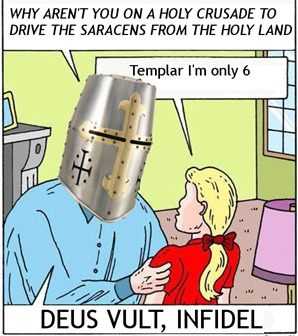
The Crusaders didn’t just leave a mark in history, they were as Legendary as they were shrouded in various Myths, but also heavily impacted European society as we know it. Not only that, it also reshaped the entire Middle Eastern continent.
And at one point even allied with the mighty Mongol empire.
But what if I told you that the Crusade isn’t what you think it originally was?
The Crusades were much more than Muslims vs. Christians. And it wasn’t the original reason why it started.
At one point, there were even Muslims joining on the Crusader’s side!
Because this region was strifed with conflict and rivalry, there was one conflict that rose above all else.
The age-old conflict between Pastoral nomads and Agricultural settlers.
The Byzantine Emperor didn’t just reach out to the Catholic pope to fight the Muslims in the heart.
Byzantine Empire was in fact in rather a good relationship with the Muslim Egyptian one, often actively trading and handing each other gifts.
And the reason they lived in relative “peace” was due to both of them being Agricultural civilizations. Settlers, builders of great cities.
It wasn’t before the arrival of the ###### ######## Pastoral nomads from the eastern steppes, who found themselves ever driven further and further westwards as the Chinese and Mongol empires drove them out from their lands.
These Turks, later known as Seljuqs, were recent converts to the Sunni faith of Islam. Meaning they also retained a lot of their Steppe-ways which would otherwise been seen as heretical.
Such as scalping the enemies, and partaking in mystic rituals.
Pastoral civilization requires a lot of land for their domestic herds of animals to graze upon.
They didn’t need cities in the same way Agricultural civilization needed them as they were always on the move.
Not only that, the Egyptian Muslims were of the Shia faith, which were staunch advisories of the Sunni faith of Islam. Many of these Shia Muslims either converted to Sunni when the Seljuk empire expanded, or was driven out of their homelands, and it didn’t take long before this expansion started pressing into Byzantine territories.
In fact, before the Byzantine Empire called for aid from his fellow Christians, the Fatamids had already declared Jihad against the Seljuk-Turk shortly before the Crusaders started their campaign towards the Holy Lands.
There were even points where an Army-funded by the Byzantine, led by Muslim Generals, fought by Christian soldiers against the Seljuks.
Religion course played a very important role and eventually became a core role of the Crusade into the Middle East.
It is easy to miss the fact that it wasn’t a war between Religions.
But more the fact it was a war between opposing cultures.
It also shows the fact that despite the ongoing crusader wars and fighting between Christian and Muslim states and empires. There were also Muslim minorities in Christian states, even the Crusader states, and Christians in Muslim states.
There were also great cultural and technological exchanges between these two.
After the First Crusade was over, and the Crusader State had established itself, the second generation of Crusaders saw themselves more as native to the lands they were born in and also incorporated a lot of Customs from what would be seen otherwise as their enemies.
Both in terms of architecture, fashion, and, linguistics.
the “Outremers” as the Crusaders were often called, became more and more distinct from the Franks that they originated from.
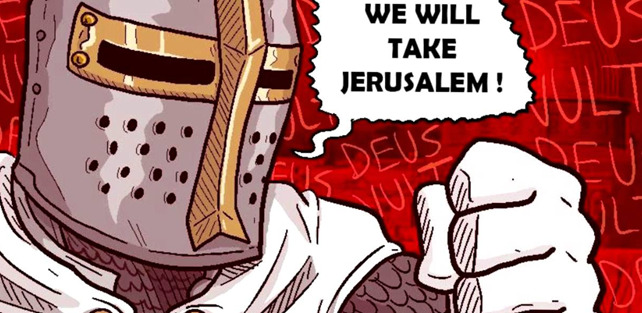
Now the Crusader states established 4 states,
The County of Edessa; The first Crusader state to be founded, and the first to fall.
Which grew prosperous on the Silk Road trade, and managed to spread its influence far and wide as the Christian Armenian locals intermarried with the Frankish nobility.
The Principality of Antioch; The Gateway to Jerusalem, and Cradle of Christianity. A city with an ancient history and at one time even rivaled Rome in its golden age.
The County of Tripoli became the major base of Operation for the Knights Hospitallers, was before a prosperous commercial and shipbuilding center, and during the crusades a busy port and a major center of silk weaving, with as many as 4000 looms producing silk products being shipped into Europe.
And then the Kingdom of Jerusalem, the crown jewel of the Crusader states, the Goal of every crusade. It was where all the major holy sites of the Christians were and of utmost importance for the Christians, it also opened the floodgates for the spice trade through the coast, where the Traderoute both from the Silk Road and the from the Red Sea with its roots to today’s modern Indonesia. Which came to shape the future of European ambitions and powers.
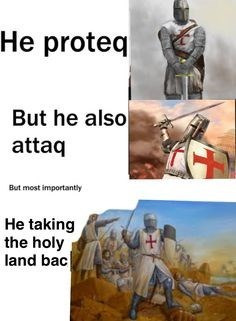
Next up:
I still dunno. The Crusader States had to be made considering I made the Order of Assassins earlier, what are Assassins without their Templar rivals eh?
Also, the Hopes for Crusader States had my imagination running wild when we got our first teasers of variant civs, artwork of Crusaders, and even screenshots of some Crusader units.
Extra notes:
IMO: Pass on OTD, gib Jerusalem.
Southeast Asia:
East Asia:
Europe:
Middle East:
Nizari Emirates - The Order of the Assassins
Crusader States - The Order of Templars ← (You are here!)
Mesoamericans:
